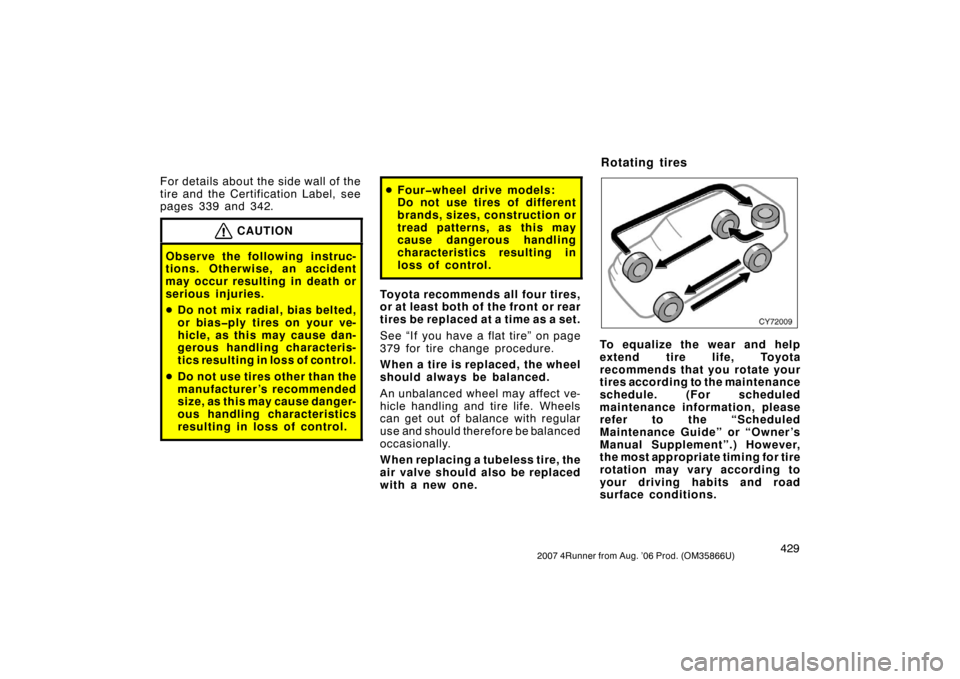Page 438 of 470

4282007 4Runner from Aug. ’06 Prod. (OM35866U)
The tires on your Toyota have built−in
tread wear indicators to help you
know when the tires need replace-
ment. When the tread depth wears to
1.6 mm (0.06 in.) or less, the indica-
tors will appear. If you can see the
indicators in two or more adjacent
grooves, the tire should be replaced.
The lower the tread, the higher the
risk of skidding.
The effectiveness of snow tires is
lost if the tread wears down below
4 mm (0.16 in.).
If you have tire damage such as
cuts, splits, cracks deep e nough to
expose the fabric, or bulges indi-
cating internal damage, the tire
should be repl aced.
If a tire often goes flat or cannot be
properly repaired due to the size or
location of a cut or other damage, it
should be replaced. If you are not
sure, consult with your Toyota dealer. If air loss occurs while driving, do not
continue driving. Driving even a short
distance can damage a tire beyond
repair.
An y ti res wh i ch are over 6 years
old must be checked by a qualified
technician even if damage is not
obvious.
Tires deteriorate with age even if they
have never or seldom been used.
This applies also to the spare tire and
tires stored for future use.
REPLACING YOUR TIRES
When replacing a tire, use a tire of
the same size and construction,
and the same or greater maximum
load as the originally installed
tires. Also, on four�wheel drive
models, all the tires must be the
same brand and have the same
tread patterns.
Using any other size or type of tire
may seriously affect handling, ride,
speedometer/odometer calibration,
ground clearance, and clearance be-
tween the body and tires or snow
chains.
Check that the maximum load of the
replaced tire is greater than 1/2 of the
Gross Axle Weight Ratings (GAWR)
of either the front axle or the rear
axle, whichever is greater. As for the
maximum load of the tire, see the load
limit at maximum cold tire inflation
pressure mentioned on the sidewall
of the tire, and as for the Gross Axle
Weight Ratings (GAWR), see the Cer-
tification Label.
Page 439 of 470

4292007 4Runner from Aug. ’06 Prod. (OM35866U)
For details about the side wall of the
tire and the Certification Label, see
pages 339 and 342.
CAUTION
Observe the following instruc-
tions. Otherwise, an accident
may occur resulting in death or
serious injuries.
�Do not mix radial, bias belted,
or bias�ply tires on your ve-
hicle, as this may cause dan-
gerous handling characteris-
tics resulting in loss of control.
� Do not use tires other than the
manufacturer’s recommended
size, as this may cause danger-
ous handling characteristics
resulting in loss of control.
�Four�wheel drive models:
Do not use tires of different
brands, sizes, construction or
tread patterns, as this may
cause dangerous handling
characteristics resulting in
loss of control.
Toyota recommends all four tires,
or at least both of the front or rear
tires be replaced at a time as a set.
See “If you have a flat tire” on page
379 for tire change procedure.
When a tire is replaced, the wheel
should always be balanced.
An unbalanced wheel may affect ve-
hicle handling and tire life. Wheels
can get out of balance with regular
use and should therefore be balanced
occasionally.
When replacing a tubeless tire, the
air valve should also be repl aced
w i t h a new on e.
CY72009
To equalize the wear and help
extend tire life, Toyota
recommends that you rotate your
tires according to the maintenance
schedule. (For scheduled
maintenance information, please
refer to the “Scheduled
Maintenance Guide” or “Owner’s
Manual Supplement”.) How ever,
the most appropriate timing for tire
rotation may vary according to
your driving habits and road
surface conditions.
Rotating tires
Page 440 of 470

4302007 4Runner from Aug. ’06 Prod. (OM35866U)
See “If you have a flat tire” on page
379 in Section 4 for tire change proce-
dure.
When rotating tires, check for uneven
wear and damage. Abnormal wear is
usually caused by incorrect tire pres-
sure, improper wheel alignment, out−
of −balance wheels, or severe braking.WHEN TO USE SNOW TIRES OR
CHAINS
Snow tires or chains are recommended
when driving on snow or ice.
On wet or dry roads, conventional tires
provide better traction than snow tires.
SNOW TIRE SELECTION
If you need snow tires, select tires of
the same size, construction and load
capacity as the originally installed tires.
Also, on four�wheel drive models, all
the tires must be the same brand and
have the same tread patterns.
Do not use tires other than those men-
tioned above. Do not install studded tires
without first checking local regulations for
possible restrictions.
CAUTION
Observe the following instructions.
Otherwise, an accident may occur re-
sulting in death or serious injuries.
�Do not use snow tires other than
the manufacturer ’s recommended si-
ze, as this may cause dangerous
handling characteristics resulting in
loss of control.
�Four�wheel drive models:
Do not use snow tires of different
brands, sizes, construction or tread
patterns, as this may cause danger-
ous handling characteristics result-
ing in loss of control.
SNOW TIRE INSTALLATION
Snow tires should be installed on all
wheels.
Installing snow tires on the front wheels
only can lead to an excessive difference
in road grip capability between the front
and rear tires which could cause loss of
vehicle control.
When storing removed tires, you should
store them in a cool dry place.
Mark the direction of rotation and be sure
to install them in the same direction when
replacing.
CAUTION
�Do not drive with the snow tires
incorrectly inflated.
�Never drive over 120 km/h (75 mph)
with any type of snow tires.
Installing snow tires and
chains
Page 461 of 470
4512007 4Runner from Aug. ’06 Prod. (OM35866U)
Tire size, cold tire inflation pressure and wheel size:Ti r e siz e
Cold tire inflation pressure kPa (kgf/cm2 or bar, psi)Wheel size
FrontRearSpare
P265/70R16 111S220 (2.2, 32)220 (2.2, 32)220 (2.2, 32)16 �7J∗
1
16 �7JJ∗
2
P265/65R17 110S220 (2.2, 32)220 (2.2, 32)220 (2.2, 32)17 �71/2JJ
P265/60R18 109H220 (2.2, 32)220 (2.2, 32)220 (2.2, 32)18 �71/2J
∗
1: Vehicles with steel wheels∗2: Vehicles with aluminum wheels
NOTE: For a complete information on tires (e.g. replacing ti res or replacing wheels), see “Checking tire inflation pres-
sure” through “Aluminum wheel precautions”, pages 425 through 432 in Section 7 −2.
Wheel nut torque, N·m (kgf·m, ft·lbf): 11 0 ( 11 . 5 , 8 3 )
Tires
Page 467 of 470

2007 4Runner from Aug. ’06Prod. (OM35866U)I
Publication No. OM35866U
Part No. 01999-35866
Printed in Japan 01−0607 −00
4
(U)
Quick index
� If a service reminder indicator or warning buzzer comes on 147 . . . . . . . .
� If your vehicle will not start 374 . . . . . . . . . . . . . . . . . . . . . . . . . . . . . . . . . . . . .\
. .
� If your engine stalls while driving 377 . . . . . . . . . . . . . . . . . . . . . . . . . . . . . . . . . .
� If your vehicle overheats 378 . . . . . . . . . . . . . . . . . . . . . . . . . . . . . . . . . . . . .\
. . . . .
� If you have a flat tire 379 . . . . . . . . . . . . . . . . . . . . . . . . . . . . . . . . . . . . .\
. . . . . . . .
� If your vehicle needs to be towed 389 . . . . . . . . . . . . . . . . . . . . . . . . . . . . . . . . .
� Tips for driving during break −in period 329 . . . . . . . . . . . . . . . . . . . . . . . . . . . . .
� How to start the engine 356 . . . . . . . . . . . . . . . . . . . . . . . . . . . . . . . . . . . . .\
. . . . . .
� General maintenance 407 . . . . . . . . . . . . . . . . . . . . . . . . . . . . . . . . . . . . .\
. . . . . . . . .
� Complete index NO TAG . . . . . . . . . . . . . . . . . . . . . . . . . . . . . . . . . . . . .\
. . . . . . . . . .
Gas station information
Fuel type:
UNLEADED gasoline, Octane Rating 87 (Research Octane Number 91) or
higher.
See page 329 for detailed information.
Fuel tank capacity:
87 L (23.0 gal., 19.1 Imp. gal.)
Engine oil:
ILSAC multigrade engine oil is recommended.
See page 421 for detailed information.
Tire information: See pages 425 through 432.
Tire inflation pressure: See page 451.
U�2